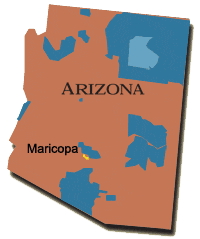| Home | About Us | Services | Success Stories | How to Help | Resources |


Arizona: Yuma, Cocopah, Maricopa
 |
ANCESTRY
The Yuma
About 3,000 Yuma Indians lived in the Southwest in the late 1600s. They were active tradesmen. They brokered shells and fishhooks from the Pacific Coast tribes in the West in exchange for baskets and pottery from tribes in the East. Although a sedentary people, the Yuma were physically superior to most of their Indian brethren. The Yuma were competent farmers despite the hot climate. Dreams were an important part of Yuma ceremony and rituals. The Yuma cremated their dead.
The Cocopah
About 3,000 Cocopah lived in the Southwest in the late 1600s. They were not aggressors, but did not mind mixing it up with neighboring tribes if attacked. In the hot summer months they lived in brush houses; during the winter they built mud huts.
Game was not plentiful where they lived so they turned to irrigated farming. They also were competent fishermen and did some gathering of wild seeds, roots, and beans.
The Maricopa
About 2,000 Maricopa lived in the Southwest in 1680. They were closely related to the Yuman. These two tribes had a falling out, and the Maricopa moved from the Colorado River Basin to live near the Pima, just west of present-day Phoenix. Despite speaking different languages, the Maricopa and Pima got along well as both grew crops along the Gila River.
The Coco-Maricopa
In about 1760 the Yuma, Cocopah, and Maricopa Indians formed one tribe known as the Coco-Maricopa ribe and lived on the Gulf of California, near the mouth of the Colorado River.
"Behold, to give justice is to punish the bad; but since none of us is bad,
what purpose will (your) justice serve?"
Name not given, Cocomaricopa





